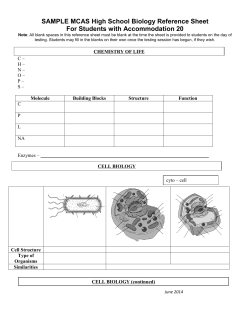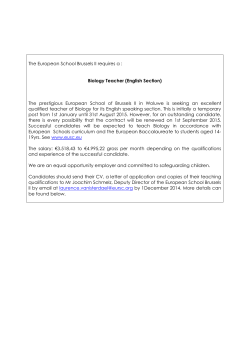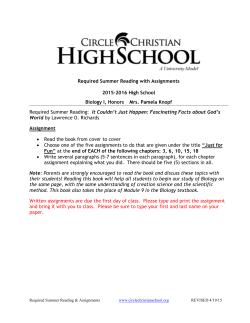
NewTools_Talk_24Apr2015_final - Consortium for Science, Policy
WORKSHOP ON THE RESEARCH AGENDA IN THE SOCIETAL ASPECTS OF SYNTHETIC BIOLOGY David H. Guston and Jenny Dyck Brian Arizona State University 24 April 2015 WHY SYNTHETIC BIOLOGY? Synthetic Biology demarcated as emerging technology because: • Diverse and dynamic nature • Rapid growth • Uncertainty but high stakes of its outcomes • Different values operative in its assessment “POLITICS OF NOVELTY” “…the decision about the novelty of nanotechnology, or synthetic biology, or geoengineering, can be settled by neither the nature nor essence of those technologies, nor by the definition nor reference to the concept of novelty itself. Rather it needs to be settled – if indeed it can be settled – by a political process that references context and the particular aspects of the novelty at stake – its purposes” (Guston 2013). THE WORKSHOP: 4-6 NOVEMBER 2014 PIs: Guston (ASU), Brian (ASU), Murray (Caltech) 115 people… • US and EU • Societal and S&E • SynBio and Other ET • Across career status • Across sectors • Across intellectual approaches OPENING PLENARY DINNER PLENARY WEDNESDAY PLENARIES: US WEDNESDAY PLENARIES: EU AN HOUR WITH ASU PRESIDENT CROW BREAKOUT SESSIONS Anticipation & Futures Bioeconomy Biosafety & Biosecurity Governance Informal Science Education Research & Innovation Systems Analysis Responsible Innovation DIY/Makers Ethics Integration & Reflexivity Public Opinion & Values Risk & Sustainability REPORT BACK FROM BREAK-OUT GROUPS: WHAT KIND OF WORK DO WE WANT TO DO? POSTER SESSION Multi-site public engagement with science – SynBio Larry Bell & David Sittenfeld Museum of Science, Boston Abstract The aim of this project is to foster activities in science museums through which public audiences can engage with scientists and engineers in conversations about synthetic biology. Conversations between researchers and public audiences will focus not only on what synthetic biology is and how research in the field is carried out, but also on the potential products, outcomes, and implications for society of this work. Researchers and publics will explore personal and societal values and priorities as well as research outcomes so that both groups can learn from each other. In the first year of the project, engagement activities will be tested at eight pilot sites across the U.S. and in the second year the project team will develop a kit of materials that will be distributed to 200 sites to support widespread public engagement with synthetic biology across the U.S. MSPES is aimed at moving from public understanding of science in informal education to public engagement with science Logic Model PES in terms of informal science education refers to activities, events, or interactions characterized by mutual learning—not one-way transmission from experts to publics—among people of varied backgrounds, scientific expertise, and life experiences who articulate and discuss their perspectives, ideas, knowledge, and values (McCallie et al, 2009). While it involves public engagement, the project is really aimed at raising the capacity of science museums and scientists to engage the public in multi-directional conversations about the societal implications of a developing technology with potentially profound implications. This project is funded by the Advancing Informal STEM Learning (AISL) program in the Division of Research on Learning in Formal and Informal Settings (DRL) with support from Systems and Synthetic Biology, BIOTECH, BIOCHEM & BIOMASS ENG. Building a community of practice for PES The MSPES-SynBio project brings together several large networks of researchers and informal educators to build a community of practice around public engagement with science. Two examples drawn from nanoscale informal science education:" " Example 1: Tabletop activities that " engage exhibit hall visitors in " consideration of priorities for technological development from " various perspectives." " " References Engagement events at pilot sites in 2015 and 200 sites in 2016 Bell, L., & Kollmann, E. K. (2011). Strategic directions for PES . Retrieved 10/23/14, from http://dimensionsofpes.wikispaces.com/Strategic+Directions+for+PES Gutmann, A., Wagner, J., Yolanda, A., Christine Grady, R. N., Anita, L. A., Stephen, L. H., ... & Nelson, L.M. (2010). New Directions: The Ethics of Synthetic Biology and Emerging Technologies. The Presidential Commission for the study of Bioethical Issues, US, 1-92. Iacovelli, S., Beyer, M., & Kollmann, E.K. (2012) Dimensions of Public Engagement with Science Summative Evaluation. Boston, MA: Museum of Science. Kollmann, E.K. (2011). Connecting university-affiliated individuals with nano informal science education. In C. Reich, J. Goss, E. K. Kollmann, J. Morgan & A. G. Nelson (Eds.), Review of NISE Network evaluation findings: Years 1-5 . Boston, MA: NISE Network. Kollmann, E. K., Bell, L., Beyer, M., & Iacovelli, S. (2012). Clusters of informal science education projects: From public understanding of science to public engagement with science. In H. van Lente, C. Coenen, T. Fleischer, K. Konrad, L. Krabbenborg, C. Milburn, F. Thoreau & T. B. Zulsdorf (Eds.), Little by little: Expansions of nanoscience and emerging technologies (pp. 65-76). Amsterdam: IOS Press. dom. • Sciencenter, Ithaca • NY Hall of Science • Mus of Life & Science • Science Museum of Minn • Pacific Science Center • Chabot Space & Sci Cntr • Arizona Science Center • Museum of Science • The Franklin Institute • Oregon Mus of Sci & Ind • Arizona Science Center • Children’s Mus of Houston • Arizona State University • Cornell University • Genspace • Massachusetts Inst of Technology • North Carolina State University • Rice University • University of California-Berkeley • University of Minnesota • University of Washington Example 2: Forums – dialogue programs – that engage experts and publics in multi-directional learning in dialogue about socioscientific questions that cannot be answered by science alone." McCallie, E.L., Bell, L., Lohwater, T., Falk, J.H., Lehr, J.L., Lewenstein, B., et al. (2009). Many experts, many audiences: Public engagement with science and informal science education. A CAISE Inquiry Group report. Washington, D.C. Museums matched with scientists for 2015 pilot activities followed by the distribution of a kit using NISE Net infrastructure to reach 200 locations." Acknowledgements We want to thank Liz Kollmann (Co-PI, MOS), Natalie Kuldell ( Co-PI, MIT), Tiffany Lohwater (Co-PI, AAAS), Jeanne Braha (AAAS), Catherine McCarthy (SMM), Ali Jackson (Sciencenter), Camellia Sanford (Rockman et al), Megan Palmer (SynBerc), and others in NISE Net, CNS-ASU, and ECAST for their support in developing this project. This project is supported by the National Science Foundation under Award Number 1421179. Any opinions, findings, conclusions expressed in this poster are those of the authors and do not necessarily reflect the views of the foundation. " Societal aspects of synthetic biology: Organisms and contexts matter Amy K. Wolfe (wolfeak@ornl.gov) Oak Ridge National Laboratory, Oak Ridge, TN Abstract Specificity about “synthetic biology” matters… This poster focuses on a single proposition: Example: Governance Specific synthetic biology attributes have substantive, potentially significant, implications for social science research " Multiple sets of rules apply…here, from a formalized, federal perspective" " " APHIS Organism type TSCA FIFRA CWA NEPA FDCA ESA NIH (PPA) " ! " Microbes! x x x " " Plants! x x x x x " Algae! x x x x x x " General/not " x x x x specified! " Illustrative, not intended to be comprehensive." " Research on societal aspects of synthetic biology should be specific about the organisms and contexts to which they apply.1 1 Building upon Shumpert, BL, AK Wolfe, DJ Bjornstad, S Wang, MF Campa, 2014, Specificity and engagement: Increasing ELSI’s relevance to nano-scientists. Nanoethics 8:193–200, DOI 10.1007/s11569-014-0194-x. “Synthetic biology” entails tremendous diversity " Examples: Potential risks Organism type ! Potential risks vary by organism…whether considered from standpoints of human health or environmental risks or from an application perspective " " " Application" Agriculture, " " "Renewable "" " Organism type ! energy Microbes! o Parties involved at different stages o Parties affected at different stages o Impacts at different stages • Extent, magnitude, duration, distribution… • Social, human health, environmental… • Plants! • Screen shots from Google “synthetic biology images” search" Algae! • • • General/not specified! • • Acknowledgements This material is based upon work supported by the U.S. Department of Energy, Office of Science, Office of Biological and Environmental Research. However, the opinions expressed are my own. David Bjornstad, Barry Shumpert, Maria Fernanda Campa, Kimberly Davis, and Savannah Stelling contributed to the ideas and information contained in this poster. o Upstream or public engagement, responsible innovation, public attitudes and opinions, communications, bioethics, governance, costs vs. benefits, risk, etc. " Human Health" " References 1-13" • Definitions • Technical approaches to modification • Goals of modification • Types of organisms modified • Potential uses of modified organisms, their products, and byproducts • Contexts of commercialization, production, dissemination, use, and disposal • Applicable regulations • Etc. " Incorporating such specificity can:" " • Enhance research on societal aspects of synthetic biology • Medical food, and environmental • New(or(sturdier( pests(that(are( hard(to(control( • Unintended( (4)( • immune( • Increased( response(caused( pes&cide( by(new(cell( resistance((4)(( therapies((4)(( • Growth(of( invasive(species( (4)(( Added(pressure( • New(or(sturdier( on(land( pests(that(are( affec&ng(food( hard(to(control( produc&on,( (4)(( communi&es,( • Increased( and(current( pes&cide( ecosystems((4)(( resistance((4)( Compe&&on( with(na&ve( algal(species((4)( Deple&on(of( vital(nutrients( (4)( Further(spread( to(other( ecosystems((4)( Evolu&on(of( novel,( poten&ally( • Evolu&on(of( • • Evolu&on(of( harmful( novel,( novel,( characteris&cs( • poten&ally( poten&ally( (14)( harmful( harmful( Uncontrolled( characteris&cs( characteris&cs( (14)( prolifera&on((4)(( (14)( Contamina&on( • Uncontrolled( • Uncontrolled( of(surrounding( prolifera&on((4)(( prolifera&on((4)(( environments( • Contamina&on( • Contamina&on( (4)(( of(surrounding( of(surrounding( Undesired( environments(( environments(( crossMbreeding( (4)( " Illustrative, and based on our review of the literature" Numbers in parentheses refer to references in the box to the right" " Microbes! Bioterrorism Plants! Crea&on(of( pathogenic( viruses(and( bacteria((17)(( Pathogenicity Organism type ! Threat(to( biosecurity((4)( DoMitMyourself( biologists(lack( necessary( educa&on(and/ or(resources(to( conduct(safe( research(with( minimal(risk( (15)((( • Evolu&on(of(novel(and( poten&ally(harmful( characteris&cs((14)(( Biodiversity • Increase the “usability” of our research results among multiple target “user” populations • Airborne(algae(can(induce( allergies((19(( • Evolu&on(of(novel(and( • Evolu&on(of(novel(and( poten&ally(harmful( poten&ally(harmful( characteris&cs((14)(( characteris&cs((14)(( " Environmental" " Microbes! • Compe&&on(with(na&ve( popula&ons((17,(22)( • Difficulty(of(eradica&on((17)( Plants! • Compe&&on(with(na&ve( popula&ons((17)( • Difficulty(of(eradica&on((17)( Algae! • Compe&&on(with(na&ve( algal(species((4)( • Compe&&on(with(na&ve( phytoplankton,(ul&mately( resul&ng(in(altera&on(of( food(web(dynamics(and( geochemical(cycling((16)( • Deple&on(of(vital(nutrients( (4)( General/not specified! Toxicity • Transgenic(organisms( intended(to(be(toxic(to( pests(or(pathogens(could( • Crops(grown(for( harm(nonMtarget(species( • An&bio&c(resistance(genes( pharmaceu&cal( could(be(transferred(to( (18)( or(industrial(reasons(could( • Crops(for(pharmaceu&cal( other(organisms,( coMmingle(with(food(crops( eventually(reaching( or(industrial(reasons(could( (18)( humans(and(making( coMmingle(with(food(crops( • Food(allergies(from( pathogens(less(controllable( (18)( varie&es(equipped(with( (21)(( • Increased(risk(of(tumor( new(expression(genes((20)(( growth(from(gene&cally( modified(food(products( (20)( Algae! General/not specified! Allergies • Spread(of(infec&ous( disease(by(needle(s&cks,(or( airborne(transmission((4)( • Unintended(immune( • Unintended(infec&on(from( response(caused(by(new(cell( new(cell(therapies((4)( therapies((4)(( • Inadvertent(increase(in( pathogenicity((8)( • Further(spread(to(other( ecosystems((4)(( Land Gene dispersal • Horizontal(gene(transfer((17,( 18,(22)(( • Added(pressure(on(land( affec&ng(food(produc&on,( communi&es,(and(current( ecosystems((4)( • Increase(in(weediness(or( invasiveness((18)( • Improve our collective ability to achieve multiple research goals • Horizontal(gene(transfer((18)( • Spread(of(transgenes(by( dispersal(of(whole( organisms((18)( • Horizontal(gene(transfer((16,( 18)( • Spread(of(transgenes(by( dispersal(of(whole( organisms((18)( • Ability(to(mutate(and(evolve( (17)(( References (for tables) THURSDAY PLENARY: PRIORITY SETTING THURSDAY PLENARY: NEXT STEPS BIOECONOMY Comparative and international research will be critical for making US policy in an era of the globalization of bioeconomies and of global biological systems. Participants grappled with what gets included and what gets ignored, the mechanisms by which a bioeconomy emerges and flourishes, and what gets lost/distribution of outcomes in that transition. • Significant lack of information and very few sources of data • Research interests: history of the term, life cycle analyses of new products, comparative work on imaginative futures, and the bioeconomy in contrast to other forms of economic growth RESPONSIBLE INNOVATION Effort to try to establish more clearly articulated societal design criteria, expand the solution space, and make choices more explicit and transparent • How can innovation systems internalize RI processes as distinct from regulatory oversight? • What are the conditions that would make responsible development in syn bio possible? What processes and institutions do we need? • Systematic consideration of alternative pathways for achieving stated goals of synthetic biology research. For a given “promise”, what are other social/technical means of delivering on it? GOVERNANCE Governance is not just about regulations, but the interactions among different sources of power in society. Therefore, there is a need for creativity, flexibility and new analytic and policy frameworks. • Can governance issues be generalized across emerging technologies? • Participants requested assistance from federal agencies for creating formal pathways for research to reach policymaking bodies. Strengthening (or creating, in some cases) a more efficient feedback loop between social scientists, policymakers and scientists is a critical need. • Coordinated and systematic mappings of international/ transnational policies and governance structures as they emerge to produce comparative analyses of policies. STYLE The most important concern was finding the right balance of integrative and independent social science research. • Embeddedness model keeps social science grounded and real • The technical and social sides do not dictate what the other does; differences are complementary and open up research possibilities through awareness and humility • Specific mechanisms, such as mechanism in review process to decline funding for a poorly integrated and embedded project, may help promote appropriate degree of independence SCALE Absent a large national synthetic biology program, do we need or want a large ‘societal aspects of synthetic biology program? • Important opportunity to step away from the “ethical, legal and social implications” (ELSI) model in which the social side is funded only through the technical side. • ELSI model minimizes scope and credibility of social science and humanities work by making it contingent on scientific funding • Large scale and independent funding critical for success of cooperative and collaborative research agendas RECOMMENDATION 1 Federal agencies sponsoring synthetic biology should pay special attention to societal research on synthetic biology, even in the absence of a national initiative. RECOMMENDATION 2 Federal support for synthetic biology should ideally pursue a co-‐constructed synthetic biology that would develop a truly integrated research program and be a model of responsible innovation. RECOMMENDATION 3 Federal support for societal research on synthetic biology should include large-‐, medium-‐, and small-‐scale activities in order to achieve appropriate combinations of independence and interdisciplinary coordination. RECOMMENDATION 4 A funding model that relies solely on co-‐ funding societal research with science and engineering research should not be pursued; nevertheless, co-‐funding should still be an important instrument and proposals from both societal and S&E investigators should be evaluated in part by how well they integrate knowledge across disciplines. RECOMMENDATION 5 Federal support for synthetic biology should be sensitive to the power differentials between S&E researchers and societal researchers in designing funding models and articulating expectations. RECOMMENDATION 6 Federal support for synthetic biology should be prepared to fund societal research in a number of Bields and design programs to take advantage of potential synergies across them. RECOMMENDATION 7 Federal support for synthetic biology should consider and develop ways of connecting societal research with informal science education about synthetic biology, among other areas. RESOURCES: CNS.ASU.EDU/SYNBIO Workshop agenda Workshop posters Workshop reflections Workshop reports (workshop/eval) Interviews (coming soon) Background papers Bibliography Glossary ACKNOWLEDGEMENTS We wish to thank: Co-‐PI Richard Murray (Caltech) CSPO DC staff ~115 Workshop attendees NSF, particularly Susanne von Bodman, Theresa Goode, and Fred Kronz Disclaimer: This work is supported by NSF award #1445903 and cooperative agreement 0937591. Any opinions, Bindings and conclusions are those of the author and do not necessarily reBlect the views of the National Science Foundation.
© Copyright 2025









